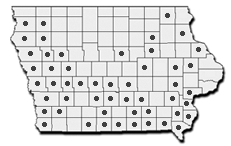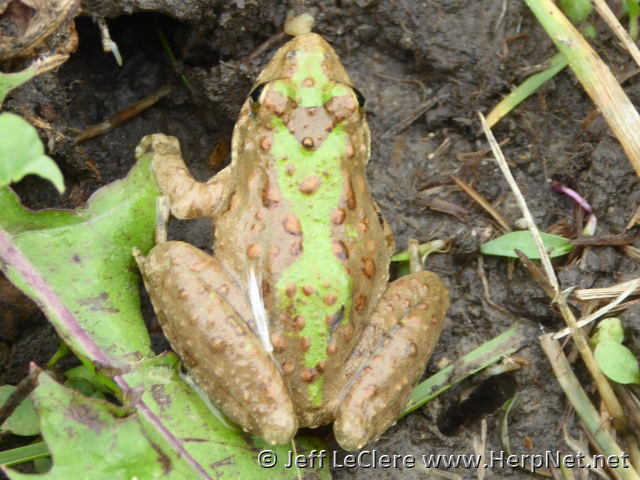Blanchard’s Cricket Frog (Acris blanchardi)
by Jeff LeClere

Blanchard’s cricket frog, Acris blanchardi, calling.
Status
Species of Greatest Conservation Need. A valid fishing license is required to possess this species for bait or food. We are interested in reports from the northern one fourth of Iowa. Former name for Iowa populations was northern cricket frog, Acris crepitans.
Description
This is one of Iowa’s smallest frog species. Adults are from 5/8 to 1 1/2 inches snout to vent length. The ground color is usually brown, gray, or green. There may be green blotches or a mid dorsal stripe that is green, red, orange, or yellow. They are warty for a moist-skinned frog, and have long, powerful legs. They have pads on the ends of their toes, but these are not easily discernible and they cannot cling to surfaces like treefrogs.
Subspecies
No subspecies of Blanchard’s cricket frog, Acris blanchardi, are recognized.
Range

The cricket frog is found statewide in Iowa. During the 1980s , it has declined from north to south. They disappeared from many of the northern counties that once had cricket frogs. They remained common in central and southern Iowa. Populations appear to be recovering during the last few years as they continue to move back northward. Anuran call surveys will hopefully track this trend.
Habitat
This frog may be found wherever there is water and is the most abundant species in much of their national range. In Iowa they are known from ponds, streams, slow moving parts rivers, or any other permanent water source. Unlike many of the other small frogs (chorus, spring peepers, treefrogs) they prefer more permanent bodies of water rather than ephemeral pools or marshes.
Habits
Blanchard’s cricket frogs are Olympic jumpers using their strong hind legs to propel themselves distances of three feet in a single jump. They hang around the waters’ edge and stay still to blend in with the muddy bank or hop into the water to escape danger. They do not like deep water, however, and instead of diving and remaining submerged like other frogs, they quickly swim in a semi-circle to another location on the shore.
Cricket frogs breed late; June and July and sometimes later, though calls may be heard in May. The males make a glicking call that sounds like two pebbles being struck together (in fact, I have elicited a reply to such sounds!). They start out slow and then increase in rapidness until the individual glicks cannot be singled out. Females lay several clutches of eggs numbering up to 200 eggs per clutch. These are attached to vegetation underwater. The tadpoles are about an inch when they hatch and they morph into froglets in about 7 weeks. The young frogs stay active later in the year than adults.
Food
These frogs eat any tiny insect they can catch. They eat incredibly large amounts of food; enough to fill their stomachs three times a day (Johnson and Christiansen, 1976).


